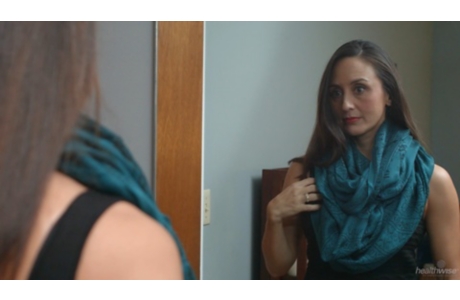Tissue Flap Surgery for Breast Reconstruction
Surgery Overview
Tissue flap surgery is a way to rebuild the shape of a breast using skin, fat, and possibly muscle from another part of the body. It is usually done after part or all of the breast is removed (mastectomy) because of cancer. It may also be done for women who have problems with breast development.
Breast reconstruction usually takes more than one surgery. The first surgery may be done during the same surgery as mastectomy, or it may be done later as a separate procedure. The nipple and the darker area around it (areola) are created at a later time.
Tissue flap surgery is done by a plastic surgeon. The breast surgeon who does your mastectomy can refer you to a plastic surgeon with special training in breast reconstruction.
You will meet with the plastic surgeon before your mastectomy to discuss the best procedure for you. The surgeon can show you pictures of other women who had the surgery you are considering. You can ask to talk to women who have had the surgery.
If you are not comfortable with the surgeon or the recommended treatment, you can see another surgeon to get a second opinion.
Types of tissue flap surgery
Tissue flap surgery may be done in two ways:
- “Pedicle flap” means the flap of tissue from the back or belly is moved to the chest without cutting its original blood supply. The tissue is pulled under the skin up to the chest area and attached.
- “Free flap” means the tissue and blood vessels are cut. After the flap is in place, the surgeon sews the blood vessels in the flap to blood vessels in the chest area. This requires careful surgery by a surgeon who does microsurgery.
Here are some of the different types of tissue flap surgery, named for the area of the body where the tissue is taken.
- TRAM (transverse rectus abdominis muscle) flap is one of the most common types of flap surgery. The surgeon takes muscle and tissue from the lower belly and moves it to the chest area. This reduces the amount of fat and skin in the lower belly and results in a “tummy tuck.” TRAM may be done as either a pedicle flap or a free flap.
- Latissimus dorsi (LD) flap is a type of pedicle flap surgery. It uses muscle, fat, and skin from the upper back that is pulled under the skin to the chest area. The scar on the back can be placed at the bra line to make it less visible. Sometimes an implant is placed during the same surgery to make the breast larger.
- DIEP (deep inferior epigastric artery perforator) flap is a free flap similar to TRAM. The surgeon takes fat and skin from the lower belly area but doesn’t use the muscle. By saving the muscle, it helps avoid later belly weakness. Like TRAM, it results in a “tummy tuck.”
- SIEA (superficial inferior epigastric artery) flap is similar to the DIEP flap. But with this surgery, the surgeon doesn’t cut through the belly muscles to get the artery used for the new breast. Like DIEP, it results in a “tummy tuck.”
- Gluteal free flap is a free flap that uses muscle, fat, and skin from the buttocks to create a new breast. This may be a good choice for thin women who don’t have enough belly tissue for DIEP or TRAM.
- TUG (transverse upper gracilis) flap is a free flap that uses tissue from the inner upper thigh to create a new breast. The scars are hidden inside the thigh and groin. Using the gracilis muscle from the thigh doesn’t leave the leg weaker. This may be a good choice for a woman who has small breasts and little belly tissue.
Another type of breast reconstruction uses just fat to create a new breast. It is called autologous fat transfer or fat grafting. Unlike tissue flap surgery, this procedure uses liposuction to remove fat from your body (often from the belly or buttocks). Then the fat cells are injected into the chest wall to create a new breast mound.
What To Expect
Tissue flap surgery is done using general anesthesia, so you sleep during the procedure. Depending on the procedure, the surgery may take several hours to complete, and you may need a blood transfusion.
When you wake up from surgery, you will have bandages over the surgery sites, and you may wear a special bra that holds your bandages in place. You will also have drainage tubes to collect fluid and keep it from building up around the surgery sites.
You will stay in the hospital about 5 days so your doctor can be sure there is good blood supply to the skin over the reconstruction. A physical therapist may show you exercises while you are still in the hospital. These can help keep your shoulder from getting stiff.
Most women have soreness, redness, and swelling in the breast and the area where the tissue was taken. The swelling may last for several weeks. You may need pain medicine for a week or two. Your doctor may also prescribe antibiotics to help prevent infection.
You may be able to go back to work or your normal routine in 6 to 9 weeks. Most women need to avoid strenuous activity for several weeks.
Why It Is Done
Tissue flap surgery is usually done to restore the appearance of a breast after mastectomy. It may also be done for women who have problems with breast development.
Breast reconstruction may help a woman feel better about her appearance. Some women say it helps them feel better about their bodies, more alive, feminine, and sexual—and happier about life.
How Well It Works
Most women who have tissue flap surgery are happy with the results. Compared to breast reconstruction with implants, tissue flap procedures require a longer surgery and recovery time but can result in a breast that looks and feels more natural.
Tissue flap surgery won’t restore normal feeling to your breast, but with time, some feeling may return.
Risks
Many of the risks associated with breast reconstruction are the same as those with any surgery: infection, poor wound healing, bleeding, or a reaction to the anesthesia used in surgery.
Other risks associated with tissue flap surgery include:
- Tissue death if blood supply to the flap is not restored. This could cause the need for more surgery.
- Collection of blood or clear fluid in the wound.
- Ongoing pain or discomfort in the breast area.
- Muscle weakness in the area where muscle is removed.
- Abnormal scarring.
Some women are at higher risk for problems, so tissue flap surgery may not be a good choice for them. This includes women who:
- Are obese.
- Have high blood pressure.
- Have diabetes.
- Smoke.
- Are in poor health.
What To Think About
It is important to know that your breasts will look different after reconstruction surgery. Your new breast may feel firmer and look rounder or flatter than your other breast. Some women have surgery on the other breast to make them look as much alike as possible.
Breast reconstruction can be a long process. It may take several months for your breast to heal. And it may be a year before you can see the final result.
The incisions will leave scars on your breasts and wherever the tissue was taken. These will fade with time. The surgeon will try to make incisions that leave as few scars as possible.
Some women want to get started with reconstruction right away. But reconstruction can also be done later. Some women may want to wait, depending on personal preference or other treatments. And some may not want reconstruction at all. Talk with your doctor to be sure you understand the pros and cons of all your options.
Women who aren’t able to have a nipple-sparing mastectomy have options if they want their new breast to have a nipple and areola. You can have surgery to create a nipple out of tissue. A tattoo can add color to the raised nipple and create an areola. Another option is a tattoo of a nipple and areola that creates a 3-dimensional look. Or you may use a prosthetic nipple and areola that attaches temporarily to your breast.
Federal law requires insurance companies that cover mastectomy for breast cancer to also cover breast reconstruction. Check with your insurance company to find out what your costs will be.
Credits
Current as of: December 19, 2018
Author: Healthwise Staff
Medical Review:Sarah Marshall MD – Family Medicine & Kathleen Romito MD – Family Medicine & Laura S. Dominici MD – General Surgery, Breast Surgical Oncology
Current as of: December 19, 2018
Author: Healthwise Staff
Medical Review:Sarah Marshall MD – Family Medicine & Kathleen Romito MD – Family Medicine & Laura S. Dominici MD – General Surgery, Breast Surgical Oncology
 TRAM Flap for Breast Reconstruction
TRAM Flap for Breast Reconstruction Latissimus Dorsi Flap for Breast Reconstruction
Latissimus Dorsi Flap for Breast Reconstruction DIEP Flap for Breast Reconstruction
DIEP Flap for Breast Reconstruction SIEA Flap for Breast Reconstruction
SIEA Flap for Breast Reconstruction Gluteal Free Flap for Breast Reconstruction
Gluteal Free Flap for Breast Reconstruction Mastectomy: Returning Home
Mastectomy: Returning Home Shoulder and Arm Exercises After Breast Surgery
Shoulder and Arm Exercises After Breast Surgery Deciding About Breast Reconstruction
Deciding About Breast Reconstruction Breast Reconstruction: How Others Decided
Breast Reconstruction: How Others Decided
This information does not replace the advice of a doctor. Healthwise, Incorporated, disclaims any warranty or liability for your use of this information. Your use of this information means that you agree to the Terms of Use. Learn how we develop our content.

